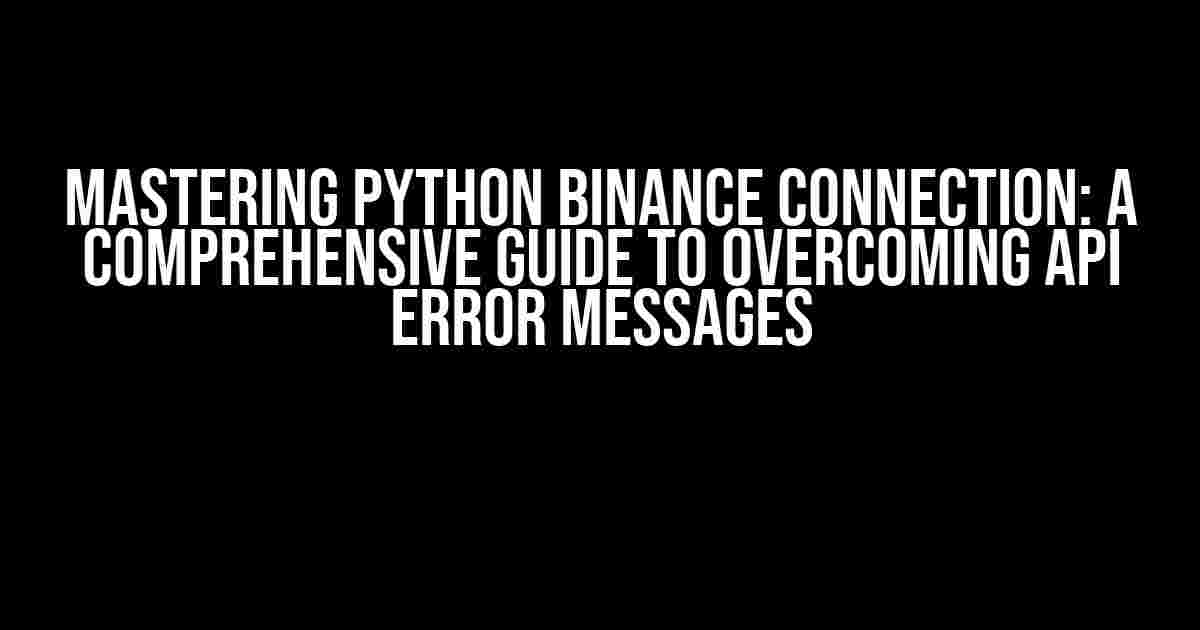If you’re a Python enthusiast venturing into the world of cryptocurrency trading with Binance, you’re likely to encounter API error messages that can be frustrating and confusing. Fear not, dear reader, for this article is your ultimate guide to understanding and resolving Python Binance connection API error messages.
What is Binance API?
Binance API is a set of programming interfaces that allow developers to access Binance’s trading platform and perform various actions, such as placing orders, retrieving account information, and accessing market data. The API provides a robust and secure way to interact with Binance, enabling you to build custom trading applications and automate your trading strategies.
Why Do API Error Messages Occur?
API error messages can occur due to a variety of reasons, including:
- Invalid API credentials or keys
- Insufficient account permissions or access rights
- Rate limiting and throttling
- Network connectivity issues
- Invalid or malformed API requests
- Server maintenance and downtime
Common Python Binance Connection API Error Messages
Here are some common Python Binance connection API error messages you may encounter:
| Error Message | Description |
|---|---|
| APIError(code=-1013): Invalid API-key, IP, or permissions for action. | Invalid API credentials or keys |
| APIError(code=-1021): Timestamp for this request was 1000ms ahead of the server’s time. | Invalid timestamp or clock skew |
| APIError(code=-1022): Signature for this request is not valid. | Invalid API signature or encryption |
| APIError(code=429): Too many requests in 1m. | Rate limiting and throttling |
| ConnectionError: (‘Connection aborted.’, ConnectionResetError(104, ‘Connection reset by peer’)) | Network connectivity issues |
Resolving API Error Messages
Now that we’ve covered the common error messages, let’s dive into the solutions and best practices to overcome them:
Invalid API Credentials or Keys
To resolve invalid API credentials or keys, follow these steps:
- Create a new API key on the Binance website
- Ensure the API key is enabled for the correct permissions and access rights
- Update your Python script with the new API key and secret key
import binance api_key = 'YOUR_API_KEY' api_secret = 'YOUR_API_SECRET' client = binance.Client(api_key, api_secret)
Invalid Timestamp or Clock Skew
To resolve invalid timestamps or clock skew, follow these steps:
- Ensure your system clock is synchronized with an NTP server
- Use the Binance API’s `getTime` endpoint to retrieve the server’s timestamp
- Use the retrieved timestamp to calculate the correct timestamp for your API requests
import binance api_key = 'YOUR_API_KEY' api_secret = 'YOUR_API_SECRET' client = binance.Client(api_key, api_secret) server_time = client.get_server_time() print(server_time)
Invalid API Signature or Encryption
To resolve invalid API signatures or encryption, follow these steps:
- Ensure you are using the correct API secret key
- Verify that your API signature is generated correctly using the HMAC-SHA256 algorithm
- Double-check that the API request is properly formatted and encoded
import binance import hmac import hashlib api_key = 'YOUR_API_KEY' api_secret = 'YOUR_API_SECRET' message = 'YOUR_API_REQUEST_DATA' signature = hmac.new(api_secret.encode(), message.encode(), hashlib.sha256).hexdigest() print(signature)
Rate Limiting and Throttling
To resolve rate limiting and throttling, follow these steps:
- Implement exponential backoff and retry logic to handle rate limit errors
- Use the Binance API’s `get_rate_limit` endpoint to retrieve the rate limit status
- Optimize your API requests to reduce the number of calls and minimize the load on the API
import binance
import time
api_key = 'YOUR_API_KEY'
api_secret = 'YOUR_API_SECRET'
client = binance.Client(api_key, api_secret)
while True:
try:
# Your API request code here
break
except binance.exceptions.BinanceAPIException as e:
if e.code == 429:
print('Rate limit exceeded. Retrying in 1 second...')
time.sleep(1)
else:
raise
Network Connectivity Issues
To resolve network connectivity issues, follow these steps:
- Check your internet connection and ensure it is stable
- Verify that your firewall or proxy settings are not blocking the API requests
- Implement retry logic with exponential backoff to handle temporary connection errors
import binance
import timeapi_key = 'YOUR_API_KEY'
api_secret = 'YOUR_API_SECRET'client = binance.Client(api_key, api_secret)
while True:
try:
# Your API request code here
break
except binance.exceptions.ConnectionException as e:
print('Connection error. Retrying in 1 second...')
time.sleep(1)Best Practices for Python Binance Connection API
To ensure a smooth and reliable experience with the Binance API, follow these best practices:
- Use a secure and unique API key and secret key
- Implement proper error handling and retry logic for API requests
- Use the Binance API's `get_rate_limit` endpoint to monitor rate limit status
- Optimize API requests to reduce the number of calls and minimize the load on the API
- Keep your system clock synchronized with an NTP server
- Use a stable and reliable internet connection
Conclusion
In conclusion, resolving Python Binance connection API error messages requires a deep understanding of the Binance API, proper error handling, and best practices. By following the instructions and guidelines outlined in this article, you'll be well-equipped to overcome common API error messages and build a robust and reliable trading application with Python.
Remember to stay up-to-date with the latest Binance API documentation and Python libraries to ensure a seamless experience. Happy coding!
Frequently Asked Question
Getting stuck with Python Binance connection API error messages? Don't worry, we've got you covered! Here are some frequently asked questions and answers to help you troubleshoot and resolve those pesky errors.
Q: Why am I getting an "API key invalid" error message when connecting to Binance with Python?
A: Double-check your API key and secret key. Make sure they are correct, and you're using the correct permissions (e.g., "READ.Info" for reading data). Also, ensure you're using the latest Binance API version and Python package.
Q: I'm getting a "Timeout" error when making API calls to Binance using Python. How can I fix this?
A: This could be due to a slow internet connection or high API request rates. Try increasing the timeout parameter in your Python script, or use an async approach to handle API requests concurrently. Additionally, ensure you're respecting Binance's API rate limits.
Q: What's causing the "Signature is invalid" error when using Python to connect to Binance API?
A: This usually occurs when the signature calculation is incorrect. Verify that you're using the correct hashing algorithm (HmacSHA256) and encoding (Base64) for your API key and secret key. Also, ensure the timestamp and other parameters are correctly formatted.
Q: I'm getting a "Margin account is not enabled" error when trying to use Binance's margin trading API with Python. What's going on?
A: This error occurs when your Binance account doesn't have margin trading enabled. You need to enable margin trading in your Binance account settings before using the margin trading API.
Q: Why do I receive an " IPs are not allowed to make requests" error when connecting to Binance API using Python?
A: This error might occur if your IP address is not whitelisted in your Binance API settings. Add the IP address of your Python script to the allowed IP addresses in your Binance API settings to resolve this issue.




